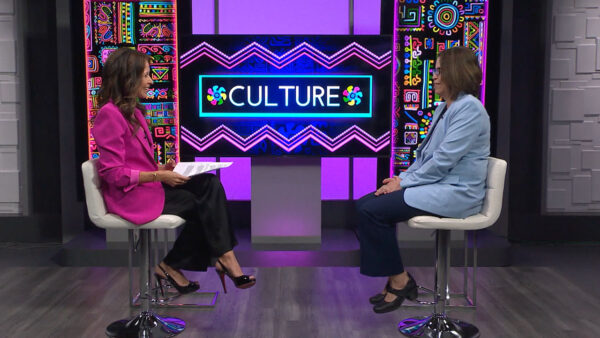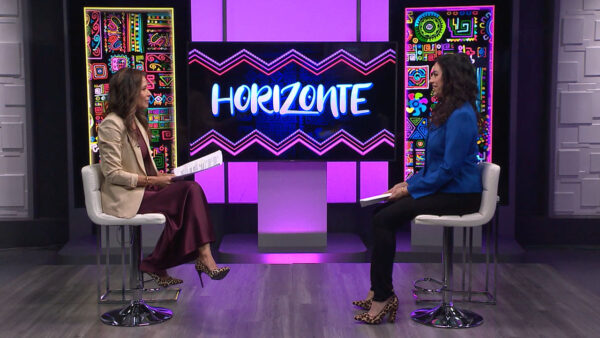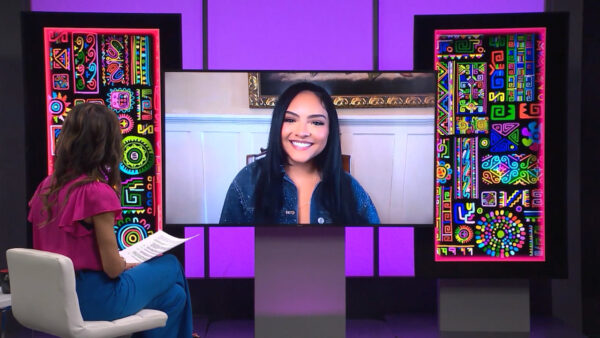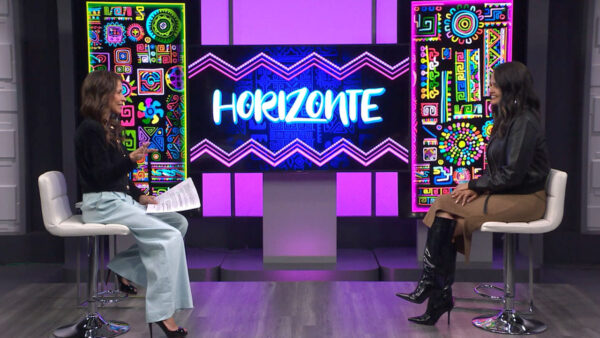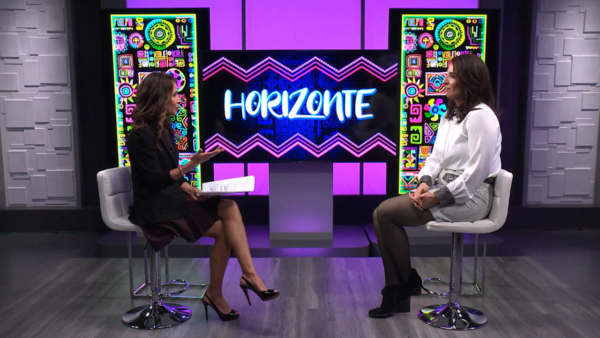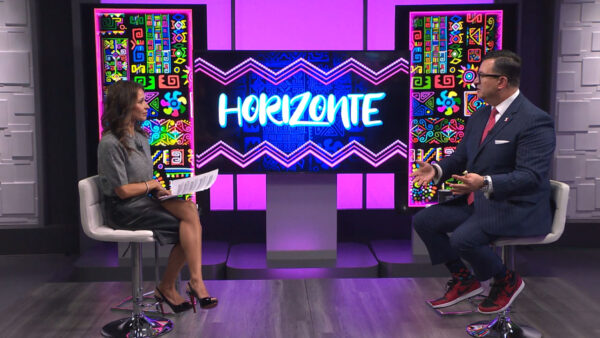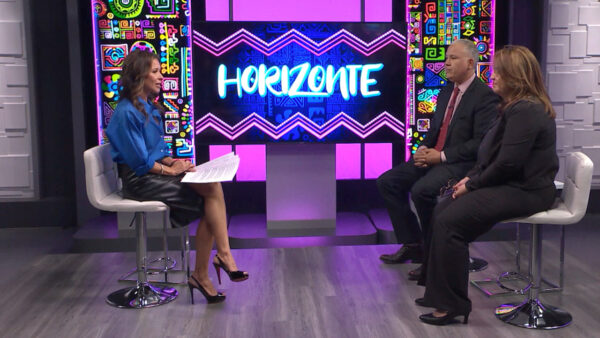Landlocked is the first video survey of Mexico City-based artist Miguel Angel Rios. The exhibition follows Rios’ journey into a unique artistic practice that addresses issues of apathy, power and violence through his innovative use of political and social narratives and original production technique. We’ll talk to artist Miguel Angel Rios and ASU Art Museum Curator Julio Cesar Morales about the exhibition.
JOSE CARDENAS: "Landlocked" is the first video survey of Mexico city-based artist Miguel Angel Rios. The exhibition follows Rios' journey into a unique artistic practice that addresses issues of power, apathy, and violence through original production technique. Joining me now to talk about the exhibition is artist Miguel Angel Rios and ASU art museum curator Julio Cesar Morales. Julio, welcome back to "Horizonte." Before we talk to you, Mr. Rios, I would like Julio you to give us a sense of what the exhibit is about, and then we'll get into more detail.
JULIO MORALES: Thank you for having me again and we have an amazing exhibition, and it's very unique because four of the projects are world premier projects. They're commissioned by the ASU art museum. We have a total of 10 videos and two documentaries and apart from that we have what we call a process room where you actually so some of the ephemera that went in all this.
JOSE CARDENAS: How does the video part work? If I go as a guest to the museum, what will I see?
JULIO MORALES: You'll see this installation of a video, a video space and especially it's an immersed sort of experience where the videos will move around you. So you'll have five different channels, five different video projections that would project the 10 different video projects, and then you go upstairs to our gallery. In a way I wanted to have the audience to have the same experience that I had when I visited him in Mexico City and walked into his studio. It's a very rare look into the artist's mind if you want to call it that.
JOSE CARDENAS: You're based in Mexico City but you're originally from Argentina. You left at the time of the junta.
MIGUEL RIOS: I am from north Argentina and I left in 75 to New York. And since then I stayed over there for many years until the military left and I came back to Argentina to visit the family, and then I returned to New York where I set up my studio and I made myself as an artist.
JOSE CARDENAS: And as I understand it, while you were in an artist when you were living in Argentina, it was in New York that you kind of develop or redeveloped yourself into a different role.
MIGUEL RIOS: Yes, I decided that in New York, I would start from zero and started some art that I was just known by -- [ Indiscernible ] Andy Warhol, etc., but after a year, I decided to look at my roots and to work with my environment and my open landscape, where I came from.
JOSE CARDENAS: We've got some pictures of one of the videos, two of the videos, actually. Some of them are stills and we've got one video of an exhibition of one of the items in the exhibit. And we're going to put it on screen now, some of the stills of the first couple of pictures I think simply reflect you working in a landscape setting. We've got those pictures here. And this is -- is this in Arizona or is this in Mexico?
MIGUEL RIOS: No, that one is in north Argentina. I was doing a video four months ago.
JOSE CARDENAS: And we've got a picture now that we want put up on the screen of actually I think we'll start with the video of some of these objects that are really items from your childhood, as I understand it. The ball. So what does that reflect?
MIGUEL RIOS: Well, those came from the games I used to play when I was eight years old in the open landscape because where I come from, it's almost a desert, and I used to play with white rolling stones and throwing down the hill with another friend and we would make a line and the one who would get closer to that was the winner. But after so many years that I was traveling around the world, I decided to work with this idea but this has very different levels. They could be people that are running from one country to another and also could be people running from the south to the north.
JOSE CARDENAS: And we see some of them shattering actually and what does that represent? Failure?
MIGUEL RIOS: Well, no, it represents you know, the traffic from Colombia, from Bolivia to the United States. I mean, each has different layers. It's not exactly about the drug but when I did the video, I was thinking about that because they found many different ways in order to traffic with the drugs from South America to the United States.
JULIO MORALES: And I think an interesting thing is, you know, no matter how many walls you're building between the United States and Mexico, I think what he's trying to say is there's also creative ways in which they make these kinds of drugs get into the United States, which is the largest consumer.
JOSE CARDENAS: People and drugs are going to get through anyway.
JULIO MORALES: They're going to get through even if you spend $8 billion on a new fence.
JOSE CARDENAS: As we've heard from proposed candidates.
JULIO MORALES: Exactly.
JOSE CARDENAS: We've got some stills of this same aspect of the exhibition we're going to put on the screen right now and Julio, are these also in the exhibit?
JULIO MORALES: Yes, and essentially, he created 1,000 of these balls made out of a mixture of cement, 3,000 and you see 3,000 balls in the video and so in the process room, in the artist's mind room, we'll call it that, you'll see some of the actual balls and the materials that were used in these videos.
JOSE CARDENAS: And you see them in flight, another picture of this scene when they're actually up in the air.
JULIO MORALES: They're actually quite heavy. They're about 10 pounds each.
MIGUEL RIOS: Something like that yes, but the idea about those is to work in the open landscape, how you can make an abstraction of the landscape and see how the rolling stones, white stones, reach their destination, which is a little bit difficult, but since I used 3,200, we were able to do it.
JOSE CARDENAS: These are magnificent pictures. That's one of the videos. We have another video that represents, and I think this one is from Mexico, from the state of Guanajuato and we've got a couple of stills from that one that we're going to put up on the screen right now. The first one the -- here's one picture, what does this represent?
MIGUEL RIOS: It's about - there is a cue there's the icon -- [ Indiscernible ] Mostly they work with the idea, the white cube, and I was trying to make this icon to go for another space, which is about poverty in South America and why I called it is because he never touched the land. Always is like floating around poverty in Mexico.
JULIO MORALES: And I think what's important is that the play is also on sort of the failure of modernity in certain regions of Latin America but the video is filmed in the dump.
JOSE CARDENAS: We've got a picture of women in the dump and this is the way they dress and this is what they do. They've got brooms there.
MIGUEL RIOS: That particular thing, in the morning when I woke up, I saw the women sweeping the garbage, not to invade their house and I said that's a fantastic idea to be able to do a shooting and I did. And I talked with them like most of them, they dressed in black like you can see.
JOSE CARDENAS: This wasn't staged. That's the way they dress.
JULIO MORALES: And these are people that live off the dump. They live off recycling the leftovers of whatever everyone's basically throwing away.
JOSE CARDENAS: Julio, we're almost out of time. Tell us, some of these were commissioned videos?
JULIO MORALES: Yes.
JOSE CARDENAS: And this represents a project you've been working on for three years.
JULIO MORALES: So this is my third year anniversary, I just got an e-mail from ASU, but essentially the first project I was working on was this project for the last three years, we've been working to have this exhibition. We got a fantastic grant from the Holly Foundation and essentially, this is an important exhibition for Phoenix, for the world, the art world, to have an amazing artist to be here and work with us.
JOSE CARDENAS: And it's a great exhibition and an artist of your caliber, you were a great influence on many artists and I hope people get out to see this show because it's terrific. Thank you for joining us on "Horizonte." And that's our show for tonight. From all of us here at "Horizonte" and Arizona PBS, thank you for watching. I'm Jose Cardenas. Have a good evening.
VIDEO: Funding for "Horizonte" is made possible by contributions by the Friends of Eight, members of your Arizona PBS station.
Miguel Angel Rios: artist; Julio Cesar Morales: ASU Art Museum Curator














